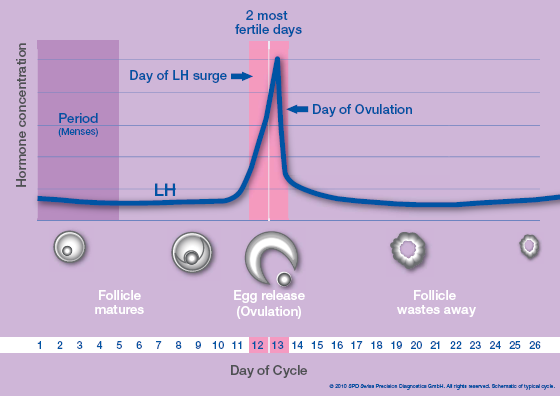 When you are trying to conceive, one thing you will surely want to know is the best time for intercourse on the purpose of impregnation. During ovulation, the chances of impregnation are highly increased. Thankfully, the body provides us with an indication of the onset of ovulation; that is the physiological event that precedes the onset of ovulation.
When you are trying to conceive, one thing you will surely want to know is the best time for intercourse on the purpose of impregnation. During ovulation, the chances of impregnation are highly increased. Thankfully, the body provides us with an indication of the onset of ovulation; that is the physiological event that precedes the onset of ovulation.
Before ovulation, the luteinizing hormone, a hormone produced in the pituitary, is released. In terms of fertility and paternity, the release process can be called LH surge. Getting clear about the relations between the LH surge and ovulation can be essential in your conception process.
What Is LH Surge?
The LH surge is essentially a signal sent from the brain to the ovary, indicating that an egg is mature. The elevated levels of estrogen caused by the production of maturing egg can be sensed by the brain, and then the brain releases a surge of luteinizing hormone. This hormone bombards the ovary and causes the sac-like coveringfolliclesurrounding the egg to thin, which enable the egg to escape.
Relations Between LH Surge and Ovulation
The LH surge and ovulationare closely related. Any detection of a burst in the release of luteinizing hormone is an indication of the onset of ovulation. The ovulation predictor kit takes effect by detecting the LH hormone or LH surge. These test kits are typically performed on a daily basis, around the time ovulation is expected to occur. The tests can be read manually via paper strips telling results by color changing, or using digital electronic device. If the reading changes from negative to positive, then it would suggest that ovulation is due to take place within 48 hours, meaning that there is a 2-day window in which to perform sexual intercourse or artificial insemination.
As the LH surge usually happens after the start of the fertile window, LH tests are generally not suggestible for contraceptive practices.
How Long After LH Surge Do You Ovulate?
With knowing the relations between LH surge and ovulation, you will naturally want to know how long you will ovulate after LH surge. According to researches, the LH surge usually occurs 24 to 36 hours ahead of the ovulation. The LH surge just give reliable signals about the peak fertile days that you can try to conceive with high chances. Thus, you can detect the LH surge to better monitor your ovulation.
How to Detect the LH Surge
Now that the relations between LH surge has been figured out, how to detect the LH surge to prepare for the pregnancy can be essential. On average, the majority of women will experience an LH surge by 8 a.m., yet it generally takes around 4 hours for the surge to be detectible when testing. Thus, it is best to perform the test around noon. Actually, a test taken between 11 a.m. to 3 p.m. should return the most accurate results.
As for women, the regularity also matters when detecting the LH surge.
- In most occurrences, for those with regular menstrual cycles, the LH surge happens between day 12 and 16 of the cycle. An ovulation predictor kit can help. An ovulation predictor kit can be used at noon or so during this time, and mostly it will yield positive results.
- For women who have irregular cycles,the results of ovulation testing kits will consistently be inconsistent; meaning a consultation with a physician may be required.
It is the unfortunate actuality that 10% of women will find the use of ovulation predictor kits ineffective, meaning that they will require help from a physician to determine their fertile window.
Should I Use Ovulation Predictor Kit to Help?
1. Pros of Using Ovulation Predicator Kit
- Preciseness. For most women, the OPK can predict 97% cases successfully, when used correctly.
- Convenience. Ovulation prediction kits require little commitment, as opposed to other methods of determining ovulation, such as recording your basal body temperature on a daily basis.
- Availability. The kits are readily available over the counter in drug stores, pharmacies, and even major supermarkets and stores. Most kits include 5 to 9 testing sticks.
- Ease to use. Ovulation prediction kits are extremely easy to use and require no special knowledge or expertise. Except that of being able to pee onto a stick.
2. Cons of Using Ovulation Predicator Kit
- Ovulation prediction kits do not test for ovulation. As mentioned, the kits measure the LH surge, not ovulation. This means that they are not a clear confirmation of whether you have ovulated.Because, there are several cases that the egg will fail to release from its follicle even after the LH surge has transpired—a condition known as luteinized un-ruptured follicle syndrome, or LUFS.
- Ovulation prediction kits don't monitor cervical mucus. To help the progress of sperm, the cervix produces a mucus to provide a fertile setting in which the sperm can easily swim through. This requires certain consistency of the mucus, but ovulation prediction kits cannot measure this.
- Certain fertility drugs can affect the effectiveness of the tests. If injectable fertility drugs are present within a person's system, such as Pergonal, the kits will often not function effectively or with reliability.
- Tests are inconsistent for older women. For women over 40, especially those reaching the age of menopause, the tests are invalid as they will always have increased levels of luteinizing hormone in their systems.
- Kits are pricey.On average, an ovulation prediction kit will cost you 15 to 50 dollars.The price varies depending on what brand you buy and how many tests are included in the kit.
